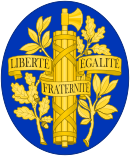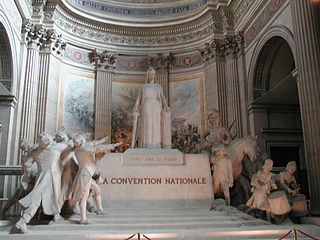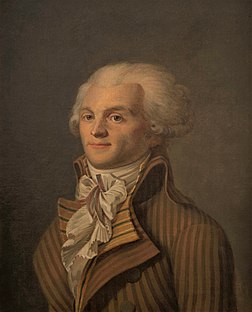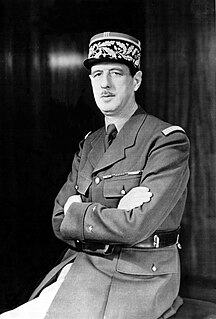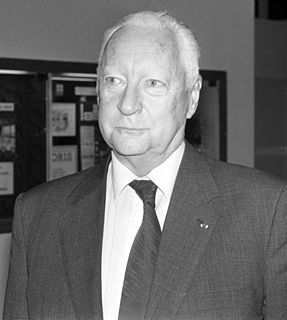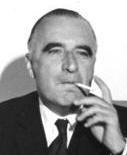| Portrait | Name
(Birth–Death) | Term of office | Political Party
(Political Coalition) | Legislature
(Election) | President
(Term) |
|---|
| 6 |  | Jules Armand Dufaure
(1798–1881) | 1 | 19 February 1871 | 24 May 1873 | Independent | National Assembly (1871) | 2 | Adolphe Thiers

(1871–1873) |
|---|
| 2 |
| 7 | | Albert, duc de Broglie
(1821–1901) | 1 | 25 May 1873 | 22 May 1874 | Monarchist | 3 | Patrice de Mac Mahon

(1873–1879) |
|---|
| 2 |
| 8 |  | Ernest Courtot de Cissey
(1810–1882) | • | 22 May 1874 | 10 March 1875 | Monarchist |
|---|
| 9 |  | Louis Buffet
(1818–1898) | • | 10 March 1875 | 23 February 1876 | Monarchist |
|---|
| 6 |  | Jules Armand Dufaure
(1798–1881) | 3 | 23 February 1876 | 12 December 1876 | Republican Left |
|---|
| 4 |
| 10 |  | Jules Simon
(1814–1896) | • | 12 December 1876 | 17 May 1877 | Republican Left | I (1876) |
|---|
| 7 | | Albert, duc de Broglie
(1821–1901) | 3 | 17 May 1877 | 23 November 1877 | Monarchist |
|---|
| 11 |  | Gaëtan de Rochebouët
(1813–1899) | • | 23 November 1877 | 13 December 1877 | Monarchist | II (1877) |
|---|
| 6 |  | Jules Armand Dufaure
(1798–1881) | 5 | 13 December 1877 | 4 February 1879 | Republican Left |
|---|
| 12 |  | William Waddington
(1826–1894) | • | 4 February 1879 | 28 December 1879 | Republican Left | 4 | Jules Grévy

(1879–1887) |
|---|
| 13 |  | Charles de Freycinet
(1828–1923) | 1 | 28 December 1879 | 23 September 1880 | Republican Union |
|---|
| 14 |  | Jules Ferry
(1832–1893) | 1 | 23 September 1880 | 14 November 1881 | Republican Left |
|---|
| 15 |  | Léon Gambetta
(1838–1882) | • | 14 November 1881 | 30 January 1882 | Republican Union | III (1881) |
|---|
| 13 |  | Charles de Freycinet
(1828–1923) | 2 | 30 January 1882 | 7 August 1882 | Republican Union |
|---|
| 16 |  | Charles Duclerc
(1812–1888) | • | 7 August 1882 | 29 January 1883 | Republican Left |
|---|
| 17 |  | Armand Fallières
(1841–1931) | • | 29 January 1883 | 21 February 1883 | Republican Left |
|---|
| 14 |  | Jules Ferry
(1832–1893) | 2 | 21 February 1883 | 6 April 1885 | Republican Left |
|---|
| 18 |  | Henri Brisson
(1835–1912) | 1 | 6 April 1885 | 7 January 1886 | Democratic Union |
|---|
| 13 |  | Charles de Freycinet
(1828–1923) | 3 | 7 January 1886 | 16 December 1886 | Democratic Union | IV (1885) |
|---|
| 19 |  | René Goblet
(1828–1905) | • | 16 December 1886 | 30 May 1887 | Radical Republican |
|---|
| 20 |  | Maurice Rouvier
(1842–1911) | 1 | 30 May 1887 | 12 December 1887 | Democratic Union |
|---|
| 21 |  | Pierre Tirard
(1827–1893) | 1 | 12 December 1887 | 3 April 1888 | Democratic Union | 5 | Marie François Sadi Carnot

(1887–1894) |
|---|
| 22 |  | Charles Floquet
(1828–1896) | • | 3 April 1888 | 22 February 1889 | Democratic Union |
|---|
| 21 |  | Pierre Tirard
(1827–1893) | 2 | 22 February 1889 | 17 March 1890 | Democratic Union |
|---|
| 13 |  | Charles de Freycinet
(1828–1923) | 4 | 17 March 1890 | 27 February 1892 | Democratic Union | V (1889) |
|---|
| 23 |  | Émile Loubet
(1838–1929) | • | 27 February 1892 | 6 December 1892 | Democratic Union |
|---|
| 24 |  | Alexandre Ribot
(1842–1923) | 1 | 6 December 1892 | 4 April 1893 | Liberal Republican Union |
|---|
| 2 |
| 25 |  | Charles Dupuy
(1851–1923) | 1 | 4 April 1893 | 3 December 1893 | Liberal Republican Union |
|---|
| 26 |  | Jean Casimir-Perier
(1847–1907) | • | 3 December 1893 | 30 May 1894 | Democratic Union | VI (1893) |
|---|
| 25 |  | Charles Dupuy
(1851–1923) | 2 | 30 May 1894 | 26 January 1895 | Liberal Republican Union |
|---|
| 3 | 6 | Jean Casimir-Perier

(1894–1895) |
| 24 |  | Alexandre Ribot
(1842–1923) | 3 | 26 January 1895 | 1 November 1895 | Liberal Republican Union | 7 | Félix Faure

(1895–1899) |
|---|
| 27 |  | Léon Bourgeois
(1851–1925) | • | 1 November 1895 | 29 April 1896 | Radical Republican |
|---|
| 28 |  | Jules Méline
(1838–1925) | • | 29 April 1896 | 28 June 1898 | Liberal Republican Union |
|---|
| 18 |  | Henri Brisson
(1835–1912) | 2 | 28 June 1898 | 1 November 1898 | Radical Republicans | VII (1898) |
|---|
| 25 |  | Charles Dupuy
(1851–1923) | 4 | 1 November 1898 | 22 June 1899 | Liberal Republican Union |
|---|
| 5 | | Émile Loubet

(1899–1906) |
| 29 |  | Pierre Waldeck-Rousseau
(1846–1904) | • | 22 June 1899 | 7 June 1902 | Democratic Union | 8 |
|---|
| 30 |  | Émile Combes
(1835–1921) | • | 7 June 1902 | 24 January 1905 | Radical-Socialist Party
( Bloc des gauches ) | VIII (1902) |
|---|
| 20 |  | Maurice Rouvier
(1842–1911) | 2 | 24 January 1905 | 12 March 1906 | Democratic Republican Alliance |
|---|
| 3 | 9 | Armand Fallières

(1906–1913) |
| 31 |  | Ferdinand Sarrien
(1840–1915) | • | 12 March 1906 | 25 October 1906 | Radical-Socialist Party |
|---|
| 32 |  | Georges Clemenceau
(1841–1929) | 1 | 25 October 1906 | 24 July 1909 | Independent | IX (1906) |
|---|
| 33 |  | Aristide Briand
(1862–1932) | 1 | 24 July 1909 | 2 March 1911 | Republican-Socialist Party |
|---|
| 2 |
| 34 |  | Ernest Monis
(1846–1929) | • | 2 March 1911 | 27 June 1911 | Radical-Socialist Party | X (1910) |
|---|
| 35 |  | Joseph Caillaux
(1863–1944) | • | 27 June 1911 | 21 January 1912 | Radical-Socialist Party |
|---|
| 36 |  | Raymond Poincaré
(1860–1934) | 1 | 21 January 1912 | 21 January 1913 | Republican Democratic Party |
|---|
| 33 |  | Aristide Briand
(1862–1932) | 3 | 21 January 1913 | 22 March 1913 | Republican-Socialist Party |
|---|
| 4 | 10 | Raymond Poincaré

(1913–1920) |
| 37 |  | Louis Barthou
(1862–1934) | • | 22 March 1913 | 9 December 1913 | Republican Democratic Party |
|---|
| 38 |  | Gaston Doumergue
(1863–1937) | 1 | 9 December 1913 | 9 June 1914 | Radical-Socialist Party |
|---|
| 24 |  | Alexandre Ribot
(1842–1923) | 4 | 9 June 1914 | 13 June 1914 | Republican Democratic Party | XI (1914) |
|---|
| 39 |  | René Viviani
(1863–1925) | 1 | 13 June 1914 | 29 October 1915 | Republican-Socialist Party |
|---|
| 2 |
| 33 |  | Aristide Briand
(1862–1932) | 5 | 29 October 1915 | 20 March 1917 | Republican-Socialist Party |
|---|
| 6 |
| 24 |  | Alexandre Ribot
(1842–1923) | 5 | 20 March 1917 | 12 September 1917 | Republican Democratic Party |
|---|
| 40 |  | Paul Painlevé
(1863–1933) | 1 | 12 September 1917 | 16 November 1917 | Republican-Socialist Party |
|---|
| 32 |  | Georges Clemenceau
(1841–1929) | 2 | 16 November 1917 | 20 January 1920 | Independent |
|---|
| 41 |  | Alexandre Millerand
(1859–1943) | 1 | 20 January 1920 | 24 September 1920 | Independent
( National Bloc ) | XII (1919) |
|---|
| 2 | 11 | Paul Deschanel

(1920) |
| 42 |  | Georges Leygues
(1857–1933) | • | 24 September 1920 | 16 January 1921 | Republican, Democratic and Social Party
( National Bloc ) | 12 | Alexandre Millerand

(1920–1924) |
|---|
| 33 |  | Aristide Briand
(1862–1932) | 7 | 16 January 1921 | 15 January 1922 | Republican-Socialist Party |
|---|
| 36 |  | Raymond Poincaré
(1860–1934) | 2 | 15 January 1922 | 8 June 1924 | Republican, Democratic and Social Party
( National Bloc ) |
|---|
| 3 |
| 43 |  | Frédéric François-Marsal
(1874–1958) | • | 8 June 1924 | 15 June 1924 | Independent
( National Bloc ) | XIII (1924) |
|---|
| 45 |  | Édouard Herriot
(1872–1957) | 1 | 15 June 1924 | 17 April 1925 | Radical-Socialist Party
( Cartel des Gauches ) | 13 | Gaston Doumergue

(1924–1931) |
|---|
| 40 |  | Paul Painlevé
(1863–1933) | 2 | 17 April 1925 | 28 November 1925 | Republican-Socialist Party
( Cartel des Gauches ) |
|---|
| 3 |
| 33 |  | Aristide Briand
(1862–1932) | 8 | 28 November 1925 | 20 July 1926 | Republican-Socialist Party
( Cartel des Gauches ) |
|---|
| 9 |
| 10 |
| 45 |  | Édouard Herriot
(1872–1957) | 2 | 20 July 1926 | 23 July 1926 | Radical-Socialist Party
( Cartel des Gauches ) |
|---|
| 36 |  | Raymond Poincaré
(1860–1934) | 4 | 23 July 1926 | 29 July 1929 | Democratic Alliance
(National Union) |
|---|
| 5 |
| 33 |  | Aristide Briand
(1862–1932) | 11 | 29 July 1929 | 2 November 1929 | Republican-Socialist Party | XIV (1928) |
|---|
| 46 |  | André Tardieu
(1876–1945) | 1 | 2 November 1929 | 21 February 1930 | Democratic Alliance |
|---|
| 47 |  | Camille Chautemps
(1885–1963) | 1 | 21 February 1930 | 2 March 1930 | Radical-Socialist Party |
|---|
| 46 |  | André Tardieu
(1876–1945) | 2 | 2 March 1930 | 13 December 1930 | Democratic Alliance |
|---|
| 48 |  | Théodore Steeg
(1868–1950) | • | 13 December 1930 | 27 January 1931 | Radical-Socialist Party |
|---|
| 49 |  | Pierre Laval
(1883–1945) | 1 | 27 January 1931 | 20 February 1932 | Independent
( National Bloc ) |
|---|
| 2 | 14 | Paul Doumer

(1931–1932) |
| 3 |
| 46 |  | André Tardieu
(1876–1945) | 3 | 20 February 1932 | 3 June 1932 | Democratic Alliance |
|---|
| 45 |  | Édouard Herriot
(1872–1957) | 3 | 3 June 1932 | 18 December 1932 | Radical-Socialist Party
( Cartel des Gauches ) | XV (1932) | 15 | Albert Lebrun

(1932–1940) |
|---|
| 50 |  | Joseph Paul-Boncour
(1873–1972) | • | 18 December 1932 | 31 January 1933 | Republican-Socialist Party
( Cartel des Gauches ) |
|---|
| 51 |  | Édouard Daladier
(1884–1970) | 1 | 31 January 1933 | 26 October 1933 | Radical-Socialist Party
( Cartel des Gauches ) |
|---|
| 52 |  | Albert Sarraut
(1872–1962) | 1 | 26 October 1933 | 26 November 1933 | Radical-Socialist Party
( Cartel des Gauches ) |
|---|
| 47 |  | Camille Chautemps
(1885–1963) | 2 | 26 November 1933 | 30 January 1934 | Radical-Socialist Party
( Cartel des Gauches ) |
|---|
| 51 |  | Édouard Daladier
(1884–1970) | 2 | 30 January 1934 | 9 February 1934 | Radical-Socialist Party
( Cartel des Gauches ) |
|---|
| 38 |  | Gaston Doumergue
(1863–1937) | 2 | 9 February 1934 | 8 November 1934 | Radical-Socialist Party
(Government of National Union) |
|---|
| 53 |  | Pierre-Étienne Flandin
(1889–1958) | 1 | 8 November 1934 | 1 June 1935 | Democratic Alliance |
|---|
| 54 |  | Fernand Bouisson
(1874–1959) | • | 1 June 1935 | 7 June 1935 | Republican-Socialist Party |
|---|
| 49 |  | Pierre Laval
(1883–1945) | 4 | 7 June 1935 | 24 January 1936 | Independent
( National Bloc ) |
|---|
| 52 |  | Albert Sarraut
(1872–1962) | 2 | 24 January 1936 | 4 June 1936 | Radical-Socialist Party |
|---|
| 55 |  | Léon Blum
(1872–1950) | 1 | 4 June 1936 | 22 June 1937 | French Section of the Workers' International
( Popular Front ) | XVI (1936) |
|---|
| 47 |  | Camille Chautemps
(1885–1963) | 3 | 22 June 1937 | 13 March 1938 | Radical-Socialist Party
( Popular Front ) |
|---|
| 4 |
| 55 |  | Léon Blum
(1872–1950) | 2 | 13 March 1938 | 10 April 1938 | French Section of the Workers' International
( Popular Front ) |
|---|
| 51 |  | Édouard Daladier
(1884–1970) | 3 | 10 April 1938 | 21 March 1940 | Radical-Socialist Party |
|---|
| 4 |
| 5 |
| 56 |  | Paul Reynaud
(1878–1966) | • | 21 March 1940 | 16 June 1940 | Democratic Alliance |
|---|
| 57 |  | Philippe Pétain
(1856–1951) | • | 16 June 1940 | 11 July 1940 | Independent |
|---|
